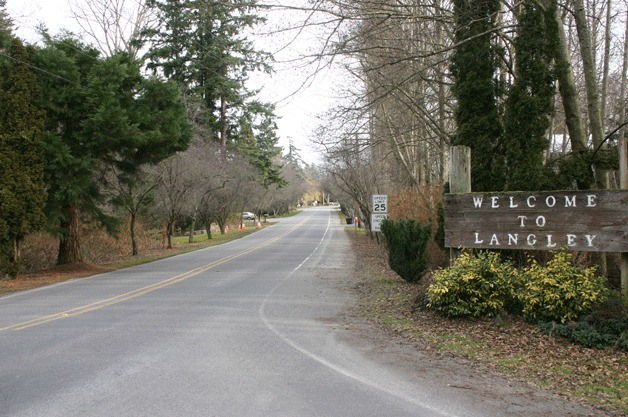Dormant for several months on the issue, the city is branching out into a new area of debate.
After more than two years of study, development of a proposed tree ordinance for Langley will come before the city’s volunteer Planning Advisory Board this week.
The ordinance would lay out a set of rules governing the protection and handling of trees in the city.
“It’s pretty rough right now,” Langley Planning Director Larry Cort said Monday. “It’s what you might expect from four or five different authors.”
Cort said the city’s planning staff has yet to weigh in on the proposals.
The PAB will take up the issue at its meeting today, at 4 p.m. at city hall. When the PAB completes its work, it is expected to send a draft tree ordinance to the city council for consideration.
“It’s just in the beginning stages,” Mayor Paul Samuelson said Monday. “It’s going to take a little while to work it through there.”
But Samuelson said he continues to believe the need for such an ordinance in Langley is real.
“It’s an important piece of what a community needs and wants,” he said, “as long it’s fair and equitable for everybody, and serves the community in a positive way.”
Jim Sundberg, PAB chairman and a member of the subcommittee, and who has worked on the proposal for more than two years, said a draft ordinance may be completed by the end of year, with submission to the city council in early 2011.
Sundberg said a tree ordinance would address such issues as the protection of “heritage trees,” many more than 100 years old; the handling of trees on construction sites; the disposition of trees on bluffs and slopes in regard to erosion; the removal or pruning of hazardous trees; and the variety of trees to plant, and those not to plant.
Efforts to come up with a tree ordinance for the city have been made through the years, but never completed, Sundberg said.
“We took up where they left off,” he said. “We realized we needed a little more vigilance.”
The latest work began in July 2008 when a PAB subcommittee was appointed to study the matter in response to the perceived damage to trees during the construction of a new Langley fire station on Camano Avenue.
An ancient Douglas fir and two or three large cedars were threatened during the installation of a sprinkler system, officials said. When a protest was filed, an arborist was retained to inspect the damage.
The roots were cleaned, the area back-filled and the trees irrigated — all with the cooperation and at the expense of the contractor, who had neglected to obtain the necessary permits.
“We realized we didn’t have an ordinance in the city to encourage public or private preservation of heritage trees,” Sundberg said.
He said work on an ordinance would center on three aspects: dealing with trees on a property during construction; the handling and preserving of trees on public property, such as those along streets; and the preservation of the city’s oldest, largest and most beautiful trees.
“We don’t want to bite off more than we can chew,” Sundberg said, “and we don’t want to intrude on private property rights.
“Hopefully, this can be a positive and popular program, rather than a burden or an intrusion,” he added.
The subcommittee, chaired by Langley resident and PAB member Fred Geisler, first met in mid-September 2008 to study the tree policies of other communities and to come up with proposed regulations for public and private property that would suit the character of the city.
The committee was made up of horticulture specialists and interested citizens.
Fran Abel, a recent addition to the city council and a landscape designer, is in favor of a tree ordinance in the city.
“I think it’s a good idea,” she said Monday. “I’ve seen many tree ordinances written in a sensitive way to allow for protection of property rights, as well as important enforcement features.”
Abel said it’s especially important to protect the city’s “heritage” trees.
“For beauty, for habitat, for shade, for air quality, for preventing erosion — there are lots of reasons to keep trees that are old and big and wonderful,” she said.
On the subject of heritage trees, new PAB member Craig Carty, a longtime veteran of the construction industry, said the proposal may have merit, but he will reserve judgement until he’s studied the issue more closely.
“My personal belief is that a government agency should not have the ability to designate and dictate without a property owner’s consent,” Carty said Monday.
Abel said the question of trees versus views also continues to be controversial, and she is adamantly against any kind of topping.
“Topping is not OK,” she said. “It’s not good for the tree and can cause a lot of long-range problems.”
Abel prefers instead the creation of “windows” in large trees by trimming branches judiciously to allow views of sea and sky.
“It’s a beautiful way to deal with views,” she said.
“Trees are pretty important in our world,” Abel added. “It’s the Evergreen State — most of us are here because we love them.”
Sundberg remains confident that city residents will get onboard with an ordinance that will protect and enhance the community’s treescape.
“There will be some controversy, as always,” he said of the PAB’s upcoming deliberations. “But my hope is that this is one of the things most of us can agree is something to be preserved.”
“And it shouldn’t stand in the way of development,” he added.
Information about the proposed tree ordinance is available online at www. langleywa.org/pab-agendas.html.



